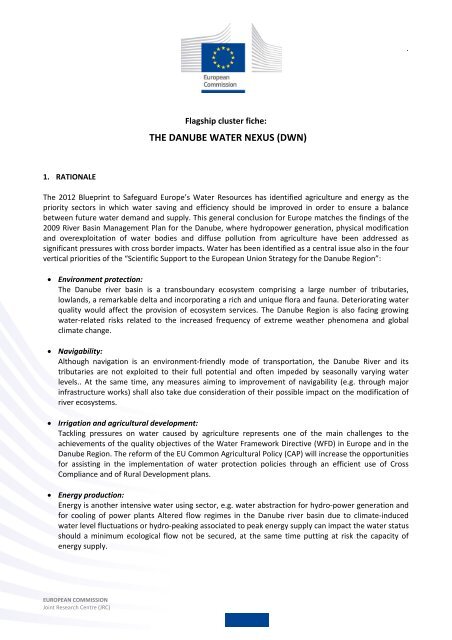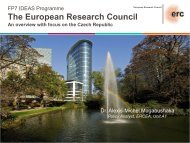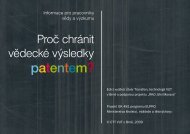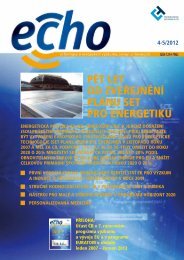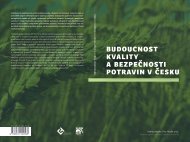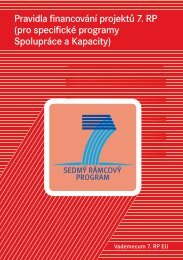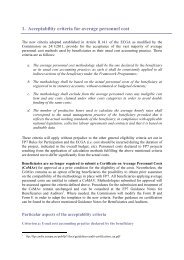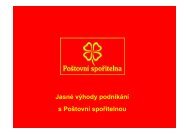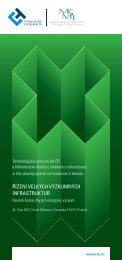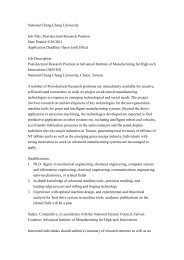Name, Surname
Name, Surname
Name, Surname
You also want an ePaper? Increase the reach of your titles
YUMPU automatically turns print PDFs into web optimized ePapers that Google loves.
.<br />
Flagship cluster fiche:<br />
THE DANUBE WATER NEXUS (DWN)<br />
1. RATIONALE<br />
The 2012 Blueprint to Safeguard Europe’s Water Resources has identified agriculture and energy as the<br />
priority sectors in which water saving and efficiency should be improved in order to ensure a balance<br />
between future water demand and supply. This general conclusion for Europe matches the findings of the<br />
2009 River Basin Management Plan for the Danube, where hydropower generation, physical modification<br />
and overexploitation of water bodies and diffuse pollution from agriculture have been addressed as<br />
significant pressures with cross border impacts. Water has been identified as a central issue also in the four<br />
vertical priorities of the “Scientific Support to the European Union Strategy for the Danube Region”:<br />
• Environment protection:<br />
The Danube river basin is a transboundary ecosystem comprising a large number of tributaries,<br />
lowlands, a remarkable delta and incorporating a rich and unique flora and fauna. Deteriorating water<br />
quality would affect the provision of ecosystem services. The Danube Region is also facing growing<br />
water-related risks related to the increased frequency of extreme weather phenomena and global<br />
climate change.<br />
• Navigability:<br />
Although navigation is an environment-friendly mode of transportation, the Danube River and its<br />
tributaries are not exploited to their full potential and often impeded by seasonally varying water<br />
levels.. At the same time, any measures aiming to improvement of navigability (e.g. through major<br />
infrastructure works) shall also take due consideration of their possible impact on the modification of<br />
river ecosystems.<br />
• Irrigation and agricultural development:<br />
Tackling pressures on water caused by agriculture represents one of the main challenges to the<br />
achievements of the quality objectives of the Water Framework Directive (WFD) in Europe and in the<br />
Danube Region. The reform of the EU Common Agricultural Policy (CAP) will increase the opportunities<br />
for assisting in the implementation of water protection policies through an efficient use of Cross<br />
Compliance and of Rural Development plans.<br />
• Energy production:<br />
Energy is another intensive water using sector, e.g. water abstraction for hydro-power generation and<br />
for cooling of power plants Altered flow regimes in the Danube river basin due to climate-induced<br />
water level fluctuations or hydro-peaking associated to peak energy supply can impact the water status<br />
should a minimum ecological flow not be secured, at the same time putting at risk the capacity of<br />
energy supply.<br />
EUROPEAN COMMISSION<br />
Joint Research Centre (JRC)
The JRC is providing scientific support to the implementation of a range of EU policies some directly related<br />
to water (e.g. the Nitrates Directive, the Urban Waste Water Treatment Directive, the Water Framework<br />
Directive, the Priority Substances Directive, the Flood Directive, the Community civil protection mechanism)<br />
and others affecting status and availability of water through regulations of sectoral activities (e.g. the<br />
Common Agricultural Policy). The JRC is also fully engaged in the development of initiatives to support the<br />
Roadmap for a Resource Efficient Europe, which identifies water as an area where innovation is necessary<br />
to set us on a path to sustainable growth.<br />
The transboundary nature of the Danube river basin provides an opportunity for testing impacts of<br />
innovative policy actions. The JRC is collaborating with several research bodies and international<br />
organisations in the Danube Region, e.g. on monitoring of water quality in the context of the Joint Danube<br />
Surveys, the development of databases to help predict climate change and to support soil protection, the<br />
deployment of modelling-based flood alerting systems for the entire river basin. Information obtained is of<br />
direct use to stakeholders in the region and the lesson learnt, also in terms of methodological<br />
development, exportable to other river basins in Europe and beyond. In this context, the JRC is proposing<br />
to carry out an assessment of the Water-Agriculture-Energy nexus for the Danube river basin.<br />
A pressure-impacts relationship for water<br />
Related priorities of the JRC Scientific Support to the Danube Strategy initiative:<br />
Environment protection<br />
Navigability<br />
Irrigation and agricultural development<br />
Energy production<br />
Related priority areas of the EUSDR:<br />
PA 1A - Mobility – Waterways (coordinated by Austria and Romania)<br />
PA 02 - Energy (coordinated by Hungary and the Czech Republic)<br />
PA 04 - Water Quality (coordinated by Hungary and Slovakia)<br />
EUROPEAN COMMISSION<br />
Joint Research Centre (JRC)<br />
2
PA 05 - Environmental Risks (coordinated by Hungary and Romania)<br />
PA 06 - Biodiversity, landscapes, quality of air and soils (coordinated by Bavaria and Croatia)<br />
Policy context and related legislation:<br />
EU reference documents:<br />
EU Water Framework Directive and EU Blueprint to safeguard Europe's water resources<br />
EU Floods Directive<br />
EU Roadmap for a Resource Efficient Europe<br />
Common Agricultural Policy Reform<br />
EU Climate and Energy package<br />
Other reference documents:<br />
Danube River Basin Management Plan (adopted by the ICPDR in the framework of the implementation of<br />
the EU Water Framework Directive)<br />
Joint Statement on Guiding Principles for the Development of Inland Navigation and Environmental<br />
Protection in the Danube River Basin (by the ICPDR, the Danube Commission and the International Sava<br />
Commission)<br />
Declaration of Transport Ministers on effective waterway infrastructure maintenance on the Danube and<br />
its navigable tributaries<br />
International partner organisations:<br />
UNESCO<br />
International Commission for the Protection of the Danube River (ICPDR)<br />
Visegrad Group<br />
EUROPEAN COMMISSION<br />
Joint Research Centre (JRC)<br />
3
2. FLAGSHIP CLUSTER DESCRIPTION<br />
The 2012 Communication on the Blueprint to Safeguard Europe's Water Resources has set out key actions<br />
that need to be considered by water managers and policy makers in EU Member States to ensure balance<br />
of water availability and demand from different sectors and respect the needs of nature. In this context the<br />
JRC has developed a hydro-economic model to assess the impact of measures on water resources<br />
availability and allocation at European scale. One of the key actions of the Blueprint Communication<br />
concerns the further improvement of the hydro-economic model and its application at regional and river<br />
basin scale. This is intended to address the challenges of improving efficiency targets at sectoral level and<br />
to help Member States in the assessment of the cost-effectiveness of the Programmes of Measures<br />
included in their River Basin Management Plans.<br />
The 'Danube Water Nexus' flagship cluster will contribute to build the knowledge base of the Water-<br />
Agriculture-Energy nexus, carry out scenario analyses of impacts of measures taking the Danube as pilot<br />
river basin and compare results for other regions in Europe, using among others the hydro-economic model<br />
developed by the JRC.<br />
Scope:<br />
The 'Danube Water Nexus' flagship cluster will address the environmental and socio-economic<br />
consequences of changing agriculture-energy pressures on water. This requires a basin-wide perspective<br />
and cooperation with countries in the region taking into account needs of all stakeholders. Allocation of<br />
available water across different sectors needs to be integrated into the overall economic strategy of the<br />
Danube Region based on optimization concepts in order to maximize growth and minimize the<br />
environmental impact. Central to the assessment will be the development and application of an<br />
optimisation model linked with dynamic, spatially explicit water quality and quantity models allowing the<br />
selection of measures affecting water availability and water demand based on environmental and<br />
economic considerations, and hydrological extremes such as floods and droughts. Optimization will<br />
particularly focus on the competing demand between the energy, agriculture, domestic, transport and<br />
industrial sectors under a changing environment. Outcomes of the bio-physical modelling will also be useful<br />
to assess impacts of changing climate on the navigability of the river.<br />
Flagship cluster structure:<br />
The following Work Packages are proposed:<br />
♦ Database development<br />
A database on inter-dependencies across water, agriculture and energy in the Danube Region will be<br />
developed. These activities will benefit from data made available through the Danube Reference Data and<br />
Services Infrastructure (DRDSI) and at the same time will contribute to populate the DRDSI with the<br />
additional datasets collected and/or generated in the framework of the cluster. All new data will be<br />
properly documented in order to facilitate their re-use. The access to the data will be governed by rules and<br />
procedures defined for the DRSDI.<br />
• The database will cover quantity and quality aspects related to the use of water in agriculture (e.g.<br />
irrigation, animal rearing, reuse), the use of energy for water (e.g. long-distance transfers, pumping,<br />
treatment) and of water for energy (e.g. power plants, hydropower, shale gas, biofuels). It will also<br />
include socio-economic indicators such as demand functions by economic sectors, households, public<br />
utilities and unit costs of selected water management options. Activities in this Work Package will be<br />
closely linked to the cluster for the creation of a Danube Reference Data and Services Infrastructure<br />
(DRDSI).<br />
EUROPEAN COMMISSION<br />
Joint Research Centre (JRC)<br />
4
• Soil related data for Danube Basin extracted from a range of in-house pan-European assessments will<br />
be made available. For example, key soil properties, organic matter, estimated soil erosion, soil sealing<br />
intensity, salinisation, land productivity dynamics, etc. It should be noted in almost all cases, individual<br />
countries have more detailed data that the JRC. However, the information at national level is very<br />
heterogeneous, which makes large area assessment difficult. In many cases, the data held by the JRC<br />
are the only pan-Danube level information. In the medium-term, a ‘state of the environment’ style<br />
report on the soils of the Danube Basin, with collaboration of Member States (as a contribution to the<br />
State of the Environment Report for 2015)<br />
• Information on mini hydropower generation potential will be incorporated as background for the<br />
modelling and scenario analyses. The assessment methodology is under validation for assessing<br />
possible locations and productivity of mini-hydro power plants. Information on water need from<br />
bioenergy production, following the IEA-bioenergy approach that JRC has contributed to develop.<br />
♦ Hydro-economic modelling<br />
The calibration and validation of a hydro-economic model for the Danube region coupling water quantity<br />
and quality models with an economic model assessing the damage due to water shortages and with an<br />
optimisation model based on multi-criteria approaches will be undertaken. Based on a multi-criteria<br />
approach, the model will allow the selection of measures affecting water availability and demand based<br />
both on environmental and economic considerations. It will include an assessment of water footprint for<br />
energy and agricultural production in the Danube Region taking into account also trade options. This Work<br />
Package will build on the development and applications made by the JRC in the preparation of the Impact<br />
Assessment of the EU Water Blueprint for all Europe. Follow up modelling to the Blueprint needs to be<br />
streamlined at river basin scale, such as the Danube, to more closely reflect the reality in regions.<br />
• The suite of biophysical models part of the JRC Integrated Water Modelling Platform will allow<br />
accounting for the variability of the quantity and quality of water resources. Making use of the spatial<br />
database developed in the first above-mentioned work package, all hydrological elements in the<br />
Danube river basin will be linked to a network of sources and demand sites for energy production, for<br />
urban and industrial water uses, for ecological and environmental flows and agricultural needs. The<br />
latter will be based on specific modules accounting for river basin scale agricultural practices and their<br />
impacts on water. Water withdrawals and return flows will be developed for each of these demand<br />
nodes, or determined using empirical relations between water and type of productive uses.<br />
• Simulations will be carried out to assess the effects of water-retention measures, water-saving<br />
measures, and nutrient-reduction measures on several hydro-chemical indicators, such as the Water<br />
Exploitation Index (WEI), Environmental Flow indicators, the 50-year return period river discharge as an<br />
indicator for flooding, and economic losses due to water scarcity for the agricultural sector, the<br />
manufacturing-industry sector, the energy-production sector and the domestic sector.<br />
• Water resource use and management involve multiple conflicting objectives and criteria. Selecting the<br />
best appropriate combination of water management uses from numerous objectives is difficult and<br />
challenging as solutions require compromises that are acceptable by all potential stakeholders. Multi-<br />
Criteria Decision Models provide a systematic mean for comparing tradeoffs and selecting alternatives<br />
that best satisfy the decision maker’s objectives. Taking economic and environmental constraints into<br />
account, the optimisation model will allocate available water to all end users while ensuring the best<br />
tradeoffs for economic and environmental sustainability.<br />
♦ Scenario analyses<br />
This Work Package will carry out analyses of future scenarios of water demand and supply, an assessment<br />
of tradeoffs between alternative schemes of water allocation across the agriculture and energy sectors, and<br />
the selection of optimal management options to reduce vulnerability of water ecosystems and ensure a<br />
sustainable agricultural production and the provision of ecosystem services. Scenarios will be run on the<br />
basis of macroeconomic trends involving changing land use and climate conditions for 2030 and 2050<br />
EUROPEAN COMMISSION<br />
Joint Research Centre (JRC)<br />
5
taking into considerations also water requirements by industry, human consumption and the need to<br />
ensure a minimum environmental flow. Interaction is required between the JRC Integrated Water<br />
Modelling Platform, the JRC Land Use Modelling Platform, the Biophysical Model Applications platform<br />
(BioMA), the agricultural sector model CAPRI, the POLES energy model, and the regional climate modelling<br />
team. This interlinkage will allow capturing complex relations between biophysical processes and economic<br />
developments (e.g. prices, income, land use).<br />
• With the inclusion of 'greening' measures combined with the cross-compliance, the CAP represents an<br />
option to ensure that agricultural production uses natural resources in a sustainable way. Furthermore,<br />
biofuel policies may potentially impact production structure and land use having implication for farm<br />
practice adjustments, land use and overall markets developments. Agro-economic scenarios for the<br />
Danube Region will include aspects related to these policy developments and external factors and their<br />
relation to water allocation and water scarcity. A particular focus of the agro-economic analysis will be<br />
on productivity effects, market impacts, land use changes, development of incomes and their variation<br />
across regions and agricultural sectors. This work will be based on the use of the CAPRI model<br />
developed and maintained under the agro-economic modelling platform iMAP.<br />
• The changing allocation of water to and within agriculture can have impacts on agricultural production.<br />
Through bio-physical and crop modelling the impacts of a water supply modified in space and time as<br />
compared to today’s situation on cereals yield and production will be analysed and evaluated. Based on<br />
feedbacks from the second above-mentioned work package, this study will include the impact of<br />
changing irrigation water regimes (blue water) as well as changing patterns of precipitation as the<br />
natural water supply to agricultural plants (green water) due to climate change for chosen scenarios.<br />
• Regional climate scenarios will initially be those prepared for the PESETA-II study (Projection of<br />
Economic impacts of climate change in Sectors of the European Union based on boTtom-up Analysis).<br />
They are based on the work of all major regional climate modeling groups in Europe that collaborated<br />
in the FP6 ENSEMBLES project. The JRC has “bias-corrected” the output of the ENSEMBLES models, to<br />
make them useful for application in climate impact models. Near the end of 2013, new scenarios will<br />
become available in the international community and may be again bias-corrected by JRC. The use of<br />
consistent and up-to-date climate scenarios will be a strong element in the project.<br />
• The Land Use Modelling Platform (LUMP) which integrates sector-specific projections and plans (e.g. on<br />
macro-economy, agriculture, forestry, demography, transport) will provide results at a detailed<br />
geographical scale, taking full account of competing land use demands (for example for household,<br />
industrial settlements, etc.) and of spatial policy restrictions (e.g. Nature 2000 sites or other protection<br />
mechanisms). Bio-physical interactions between land, water, vegetation, are also considered. Specific<br />
scenarios of policy options (concerning e.g. regional development and cohesion) will be assessed and<br />
their impacts quantified, following selected environmental, social and economic criteria.<br />
• The energy model POLES has been extensively used in the context of mid- and long-term energy<br />
scenarios, under alternative assumptions and for different policy purposes related to the 20-20-20<br />
European initiatives amongst others. The model will be used to address the alternative patterns of<br />
exploitation of hydroelectricity in the countries of the Danube region in the scenarios addressed,<br />
depending on the water resource availability and the deployment of other power generation<br />
technologies.<br />
• The identification of the classes of water management options to be included in the scenario analysis is<br />
essential for the definition of the objectives to be evaluated in the multi-criteria decision. This<br />
assessment will use as boundary conditions the set of scenarios generated for the Danube region as<br />
identified in the previous bullets. Water management measures to be assessed will comprise e.g.<br />
improvement of the efficiency in the use of water (irrigation, energy, industrial uses), increase of water<br />
retention capacity through natural (floodplains, polders, wetlands) or technical infrastructure (dams,<br />
reservoirs), improvement of the quality of available water by changing farming practices, water transfer<br />
from one basin to another.<br />
EUROPEAN COMMISSION<br />
Joint Research Centre (JRC)<br />
6
3. OUTPUTS AND BENEFICIARIES<br />
Products:<br />
• Scenarios of environmental and economic impacts of alternative water allocation measures across<br />
competing water-using sectors (agriculture, energy, industry, human consumption, environment) for<br />
the years 2030-2050, including an assessment of the provision/valuation of ecosystem services<br />
provided by aquatic ecosystems in the Danube river basin<br />
• Methodology for modelling of water resources in the Danube river basin, integrating quantity, quality,<br />
ecology and hydro-morphology, in coordination with other tools at national and river basin level and<br />
extension to non-EU countries of the Danube Region<br />
• Development of information supporting efforts of countries and international cooperation bodies in the<br />
implementation process of the WFD and planning of medium and long-term actions for the 2 nd cycle of<br />
River Basin Management<br />
• Policy relevant data products<br />
• Seminars<br />
Potentially interested actors and/or beneficiaries of the research results:<br />
EU institutions and bodies<br />
National and regional governments of the Danube Region<br />
Other stakeholders of the Danube Region<br />
JRC CONTACT:<br />
Giovanni BIDOGLIO,<br />
Head of the Water Resource Unit,<br />
Institute for Environment and Sustainability (IES),<br />
Joint Research Centre<br />
EUROPEAN COMMISSION<br />
Joint Research Centre (JRC)<br />
7


